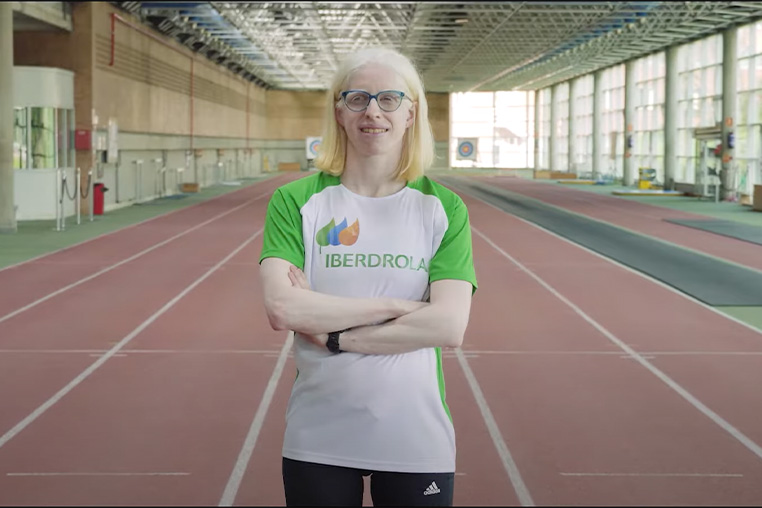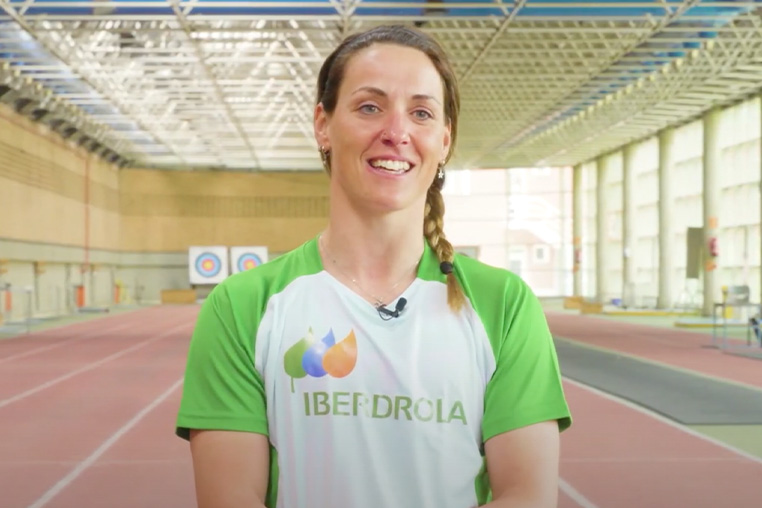How to do a triathlon
Triathlon: how to exceed your own limits
You don't have to be a super-heroine or an exceedingly talented athlete to do a triathlon; all you need is the right training and a desire to better yourself. It is a discipline in which men and women compete on equal terms, which explains the boom in women's triathlon.
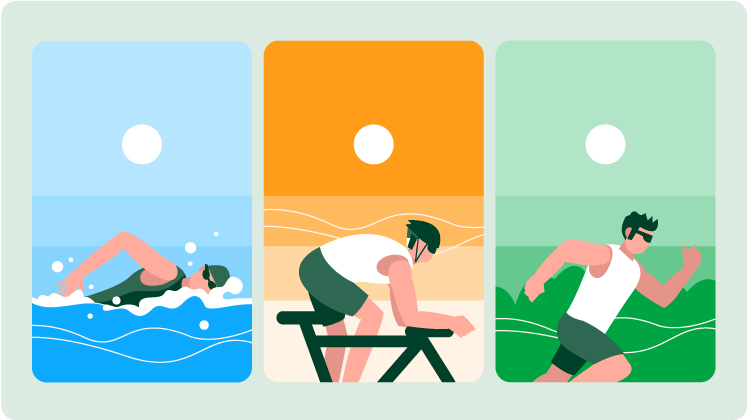
A few metres before crossing the finishing line of the 1982 Hawaii Ironman, US triathlete Julie Moss collapsed. She quickly got to her feet, but just as quickly she stumbled and fell over again. The fans simply couldn't believe what they were seeing: she got up again and drove herself on before falling to the floor once more. And it was from that unfortunate position that Julie watched Kathleen McCarthy pass her and win the Ironman. Awareness of her defeat did not demoralise this story's heroine who, after her fourth fall and rejecting the help of the crowd, managed to finish the event on all fours. Images of Moss's effort were displayed all around the world and helped put the triathlon, a sporting discipline as demanding as it was little known at the time, firmly on the map.
This exciting sport that combines three different disciplines - swimming, cycling and running - without interruptions between one event and the next is known for its enormous complexity, as it requires complete technical and physical mastery on the part of the participants in all three modalities, as well as large doses of mental endurance. In this context, it is essential for triathletes to prepare a meticulous training plan that, in the long term, will give them the conditions to face a competition that not only challenges their physical abilities, but also tests their endurance, adaptability and perseverance.
The challenges of doing a triathlon
The challenge is impressive: 1.5 kilometres swimming, 40 cycling and 10 running. These are the distances of the Olympic triathlon, but there are tougher versions. The titans who cross the finishing line of an Ironman event have completed 3.8 kilometres in the water, 180 cycling and have run a full marathon (42.195 km). These numbers might put more than one potential triathlete off when it comes to doing this sport, but one needs look no further than Julie Moss herself as the best example of anyone with the appropriate physical preparation being able to do a triathlon. Julie was a 23-year-old student who didn't fall short due to a lack of preparation, but rather because she didn't drink enough water.
Javier Gómez Noya, Spain's most successful triathlete, is another example of achievement related to this sport. In 2005, a report compiled by the Spanish National Sports Council (CSD) ruled that the heart disorder he was suffering from — congenital aortic valve disease — made him "unsuitable for top-level competition" and his licence was revoked. However, this sportsman from the Spanish region of Galicia did not give in and, after obtaining reports from a number of specialists that refuted the CSD's ruling, had his licence reinstated.
Since then success has been his constant travelling companion: five times world champion! With an outstanding track record that also includes a silver medal at the London 2012 Olympic Games, he has become living proof of the benefits of this sports discipline. We are not only talking about physical well-being — balanced muscle development of legs, arms, chest and back —, but also about mental well-being — motivation, personal satisfaction, socialisation —. And this is because triathlon is more than just a sport.
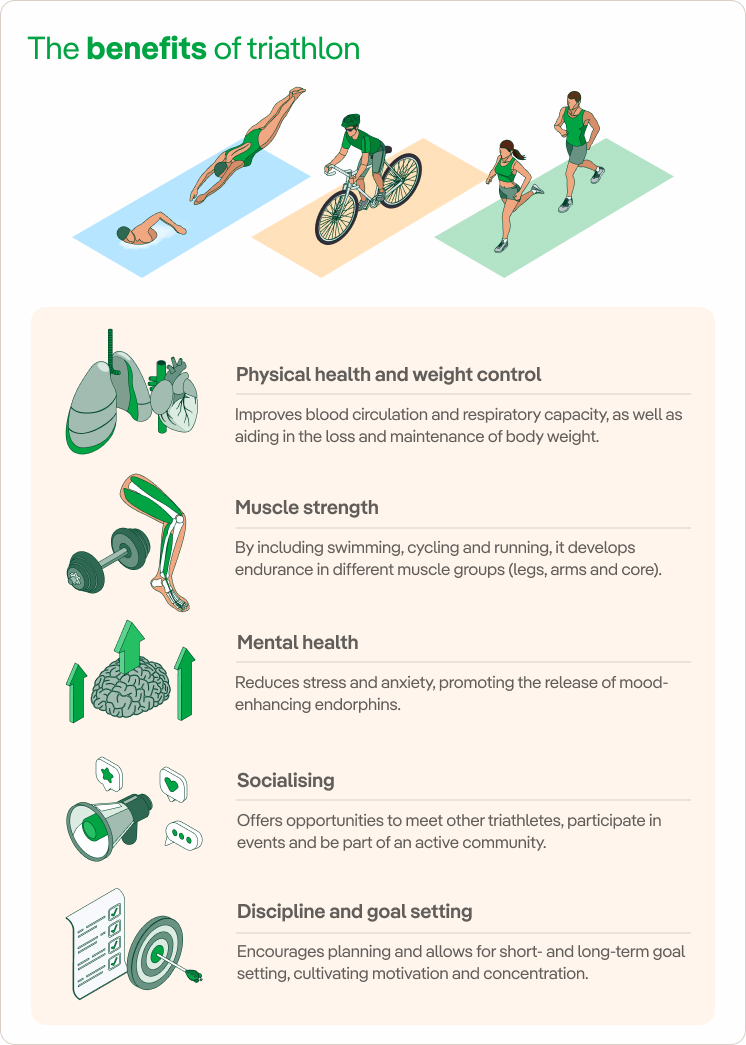
 SEE INFOGRAPHIC: The benefits of triathlon [PDF]
SEE INFOGRAPHIC: The benefits of triathlon [PDF]
Tips for tackling a triathlon
Preparing for a triathlon is not only a physical challenge, but also a comprehensive commitment to health, safety and strategy. Here are a few tips that can make all the difference in preparing for a multi-sport event such as a triathlon.
![]() Safety
Safety
Check that all your equipment is in good condition (bike, overalls, shoes, goggles, helmet, bib, water bottle, etc.) and avoid unforeseen events.
![]() Healthy living
Healthy living
Don't change your eating habits. Competing on an empty stomach, experimenting with new foods or abusing glucose before a race is not advisable.
![]() Preparation
Preparation
Write down the start time and prepare your warm-up with it in mind. Stretching before the time is useless.
![]() Caution
Caution
Check the route before the test. Knowing its particularities gives you confidence and will help you to measure your efforts and to finish the event successfully.
![]() Hydration
Hydration
During the race, regulate your pace according to your abilities and your objectives, don't forget to drink and refresh yourself!
![]() Strategy
Strategy
Prepare mentally for the test. Visualising the strategy (decision making, studying the transitions...) will help you reach your goal.
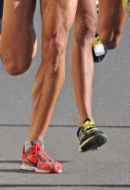
Masters Athletics
Masters athletics is gaining ground.

Trail running
Off-road running: what you need to know.

Running
Tips on how to start running.
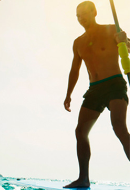
Paddle Surf
Stand up paddle surfing: surfing for everyone.
Gender equality in triathlon as a stimulus
Triathlon makes no distinction between men and women. The distances, prizes and recognition are the same for both and, perhaps for this reason, increasingly more women are taking up this young sport. Proof of this is the exponential growth it has experienced in recent years. The International Triathlon Union (ITU), the body that regulates the rules of the sport at a competitive level around the world, as well as running competitions and events, has set some ambitious goals for 2025. These include a 20 per cent increase in sponsorship-related revenue, diversification of revenue sources to avoid dependencies of more than 60 per cent and a 30 per cent increase in the total broadcast reach of its events, all compared to 2021.
This remarkable effort to popularise triathlon not only reflects the surge in interest in the sport, but has also seen the emergence of a number of leading athletes such as Great Britain's Beth Potter, who even competed in the 10,000m run event at the 2016 Rio Olympics before embarking on her triathlon journey. Her three golds and one silver at World Championships, including victory in the 2023 Pontevedra World Series final, cemented her prominence at the top of the sport. Another triathlete who has made an impact on the international stage is France's Cassandre Beaugrand, who won a bronze medal in the Mixed Relay Triathlon, an event that was held for the first time at the Olympic Games in Tokyo 2020. The event involves competing in all three sports in teams of four athletes - two men and two women - with each athlete completing their leg before the next person on the team starts their leg.
Miriam Casillas, a leading figure in women's triathlon in Spain and around the world and winner of numerous events, acknowledges that the visibility that triathlon has been given in recent years "is raising the profile of women's sport". With an extensive international career, the professional from Extremadura is another reference in triathlon and serves as an inspiration for thousands of girls and young women. "If at least one more person in the world starts doing sport thanks to me, I think that's what I'm going to take with me when I stop being a triathlete", confesses the winner of four medals at the Triathlon World Championships, the last one a silver medal at the 2019 edition held in Weihai (China).
But it is important to highlight that the impact of this sport also extends to the paralympic field. Athletes such as Susana Rodríguez and Eva Moral are inspiring examples of how triathlon knows no barriers and can offer opportunities for everyone. Susana has demonstrated this with a career full of success, standing out as a symbol of perseverance and self-improvement. She has nine World Championship medals and eight European Championship medals to her name, in addition to the gold medal won at the 2020 Tokyo Games - the first Spanish gold medal in the history of paralympic triathlon.
Eva Moral is another icon of Spanish paralympic triathlon. Like Susana, she also made her dream come true during the Games in Japan: she won the bronze medal in the PTWC (wheelchair) category.
Susana Rodríguez: Paralympic Triathlete
Eva Moral: Ellas Valen Oro
At Iberdrola, we are proud to be one of the main sponsors of Spanish women's triathlon, promoting this sport through its athletes and its competitions. The agreement with the Spanish Triathlon Federation was one of the first signed when we began our commitment to women's sport in 2016, and today we remain 100% committed to this sport.
We currently give our name to some of the most important national competitions: both the King’s Cup and the Queen’s Cup Iberdrola de Triathlon as well as the Iberdrola Triathlon League, a top-level competition contested by 15 women's teams and spread over seven days and three venues.





